The Samsung Galaxy S6 and S6 edge Review
by Joshua Ho on April 17, 2015 9:00 AM EST- Posted in
- Smartphones
- Samsung
- Mobile
- Galaxy S6
- Galaxy S6 Edge
Display
As we briefly discussed in our look at the specifications, the Galaxy S6 line introduces a newer generation of AMOLED displays, which is said to increase maximum luminance to 600 nits. Samsung claims that this was achieved with the use of new materials, which is likely necessary in order to sustain power efficiency improvements. It doesn't seem that AMOLED is uniquely suited to high resolution, but rather that Samsung Display Corp. is managing to dramatically improve how they make AMOLED displays with every year that offset power consumption increases from higher resolution displays.
To find out how Samsung did, we use SpectraCal's CalMAN 5 Ultimate, in addition to X-Rite's i1Pro2 Basic to characterize displays as accurately as possible.
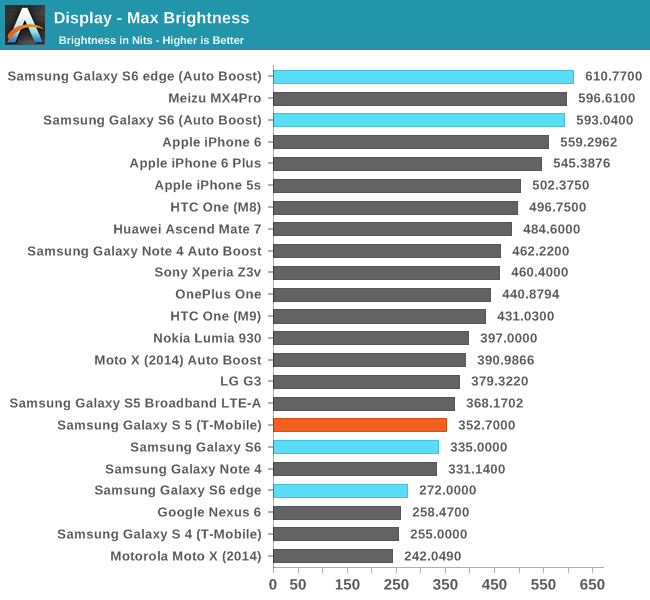
From the results Samsung's claims of a 600 nit display are valid in this case, which is a 100% APL white display. It's important to note that achieving this requires the use of auto-brightness, and that manual brightness is limited to a much lower brightness to reduce power usage, here the S6 sees similar maximum brightness as the S5. The S6 edge disappointingly only achieves 272 nits in this mode, a rather low value. I saw color balance shift dramatically in auto-boost mode, which suggests that this operating mode is likely less efficient than manual brightness. As an explanation, we've seen that colors are controlled in AMOLED by voltage while brightness is controlled by PWM (pulse width modulation). As with most recent AMOLED displays, there's no DC bias to the pixels so the contrast really is infinite instead of just a very large number when displaying black.
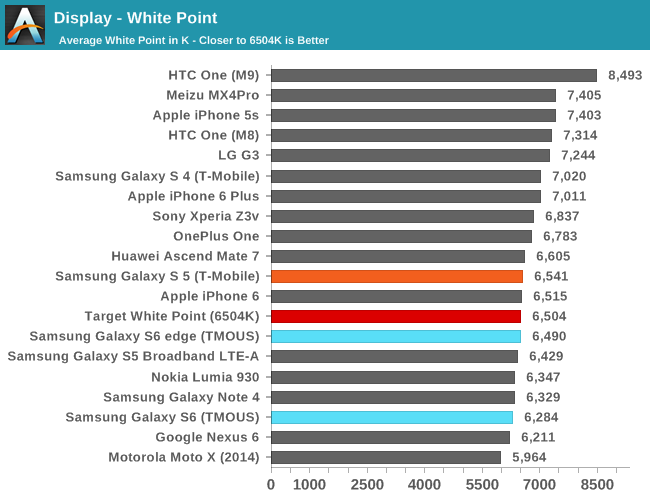

Moving on to grayscale, we can see that Samsung has done a pretty good job of controlling the white point and gamma across the saturation sweep, even if green is slightly dominant in both displays. We can also see that there is variation across displays as the S6 edge is closer to neutral while the S6 sample tends a bit warmer.
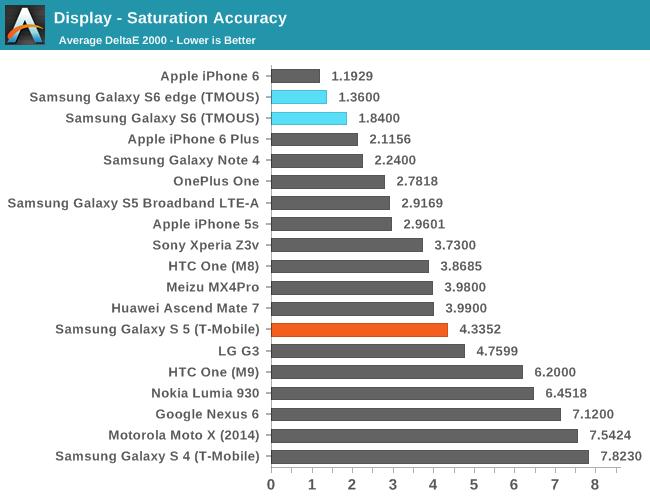
In the saturation sweep, both displays do an incredible job. I really don't have anything else to say here, because there's really no way to improve on the level of calibration Samsung has done on this display. Unless Samsung calibrates every single display in production, which is wildly impractical and effectively impossible to do, this is as good as it gets for a mass-produced device. Improving past this point will also be incredibly difficult to perceive, which means there's no real reason to go any further.
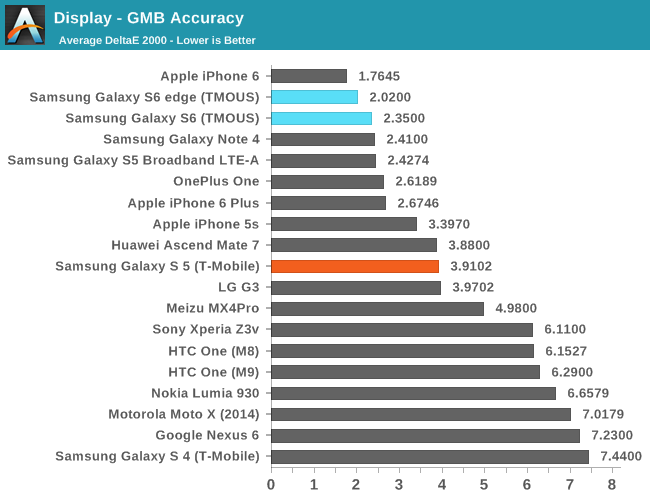
In the Gretag MacBeth ColorChecker, we can get an idea for overall color accuracy, which paints a picture similar to the saturation test. The only real problem I've noticed with these displays are the viewing angles, which can produce color shifting when the display is tilted. This is a bit of an issue on the edge variant as I can see that the edges of the display appear somewhat green when viewed head on, but otherwise there are no real issues to be seen here.
Overall, from a color standpoint it’s looking like Samsung has made one of the best displays available on the market today. Color accuracy is at the point where it’s pretty safe to say that the calibration doesn’t have clear color errors, and the peak brightness of the display is incredibly high. The 1440p resolution helps to compensate for the PenTile subpixel layout so in practice it’s effectively impossible to make out any pixels or the subpixel pattern. The contrast remains infinite as with most modern AMOLED displays, and overall it’s really hard to find any issue with the Galaxy S6’s display at first.
However while the S6 edge seems to be without any issues, the S6 does have some odd display issues that can be seen in direct sunlight as seen in the photo above. To be clear about this the photo above is a simple white screen, which should make the image completely homogeneous but instead there are two visible vertical lines and another jagged horizontal line that appear across the display. Inspection under a light microscope doesn’t really reveal what’s causing this, but the defect is quite visible in practice as seen in the photo above. I suspect that defects are rare, and in any condition other than direct sunlight I can’t see this visual problem.
While trying to see what this kind of defect looked like under a microscope, I also went ahead and took some photos of the subpixel pattern. As far as I can tell, it looks like the green subpixels have a bit more variance than what we’re used to as they tend towards oblong shapes rather than circles, which is likely due to the much tighter pixel density. It seems that this variance may cause some color shifting in certain units, which seems to remain a potential problem with Samsung's AMOLED displays. The pixel fill factor still remains surprisingly low when compared to LCDs, which usually have much higher active area. Due to the subpixel arrangement and some other differences in the display design, color shifting also remains higher than one would expect from LCD displays that are found in phones like the iPhone 6.
The final test that I managed to run on the Galaxy S6 is the brightness vs APL test, which shows the advantage of AMOLED’s emissive nature as it can dynamically increase brightness if the entire display isn’t showing a white screen. As a result, this means that in low APL scenarios like dark movie scenes and app themes it’s possible to see a maximum brightness closer to 700 nits or higher. However, in practice the display’s practical brightness is closer to 600 nits.
Overall, the display is still one of the best on the market, but I would be a bit concerned about fill factor for VR applications as that was a problem on the Note 4. Issues like purple smearing have been resolved, but there are still some problems with the display such as color shifting with changes to viewing angles and some variability in display quality from unit to unit. With this generation I suspect Samsung is either meeting or exceeding the best LCDs in quality, and with the next generation of AMOLED it’s likely that high end smartphones will have to migrate to AMOLED to remain competitive.



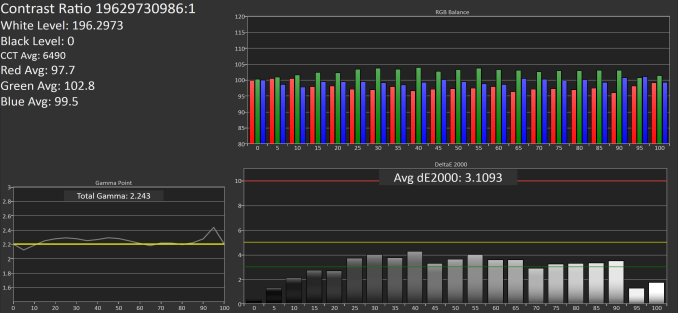
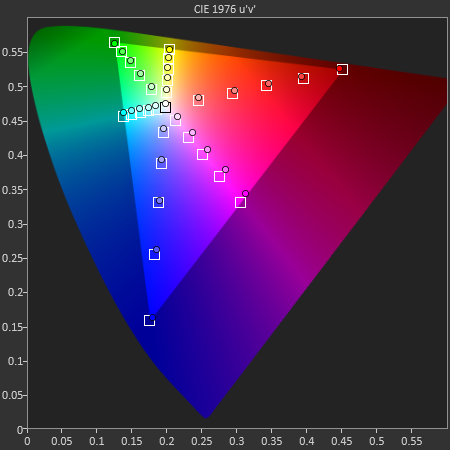
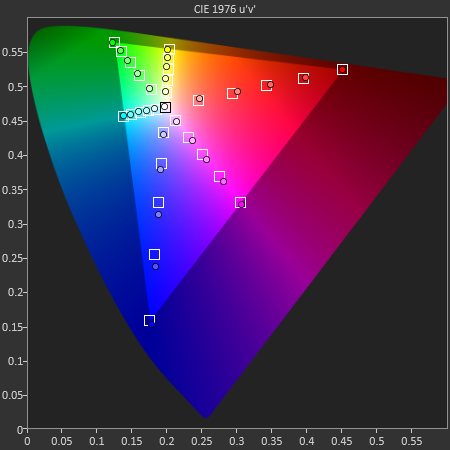
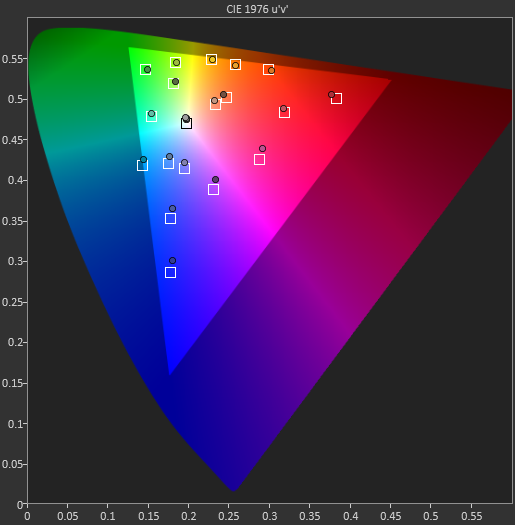

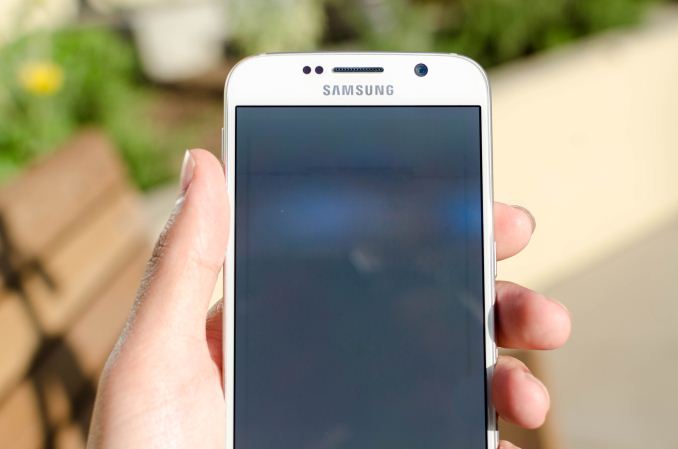
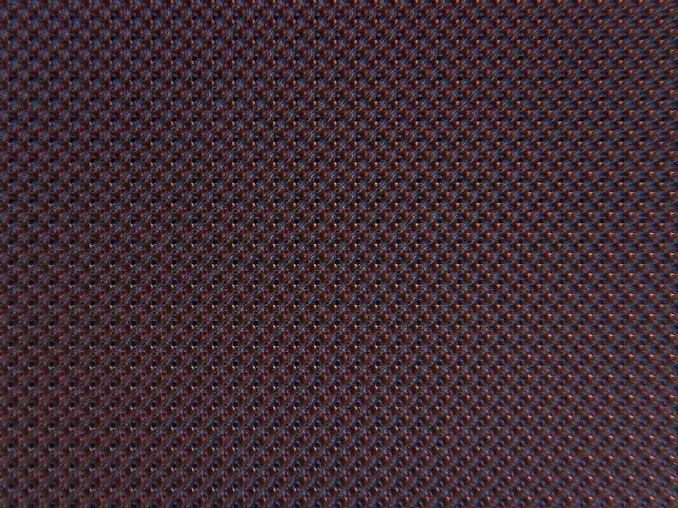
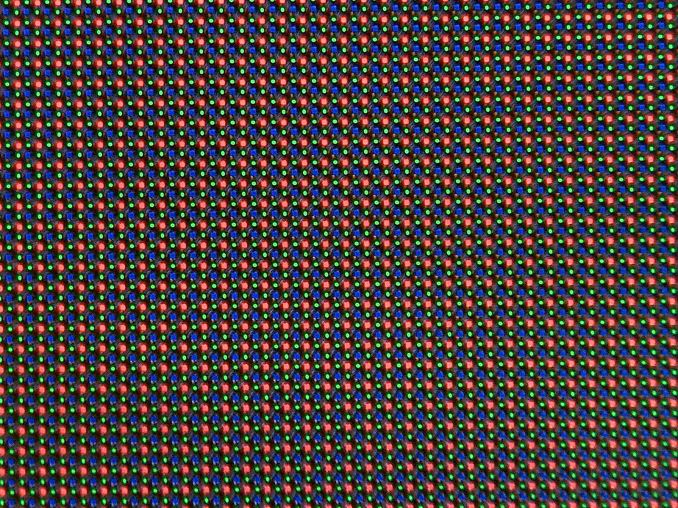
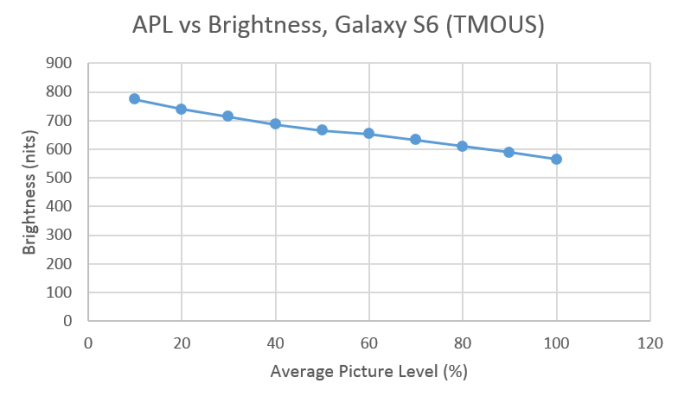








306 Comments
View All Comments
Andrei Frumusanu - Friday, April 17, 2015 - link
Math is hard, corrected, thank you.Arbie - Friday, April 17, 2015 - link
SD Police here: no microSD, no sale. The reasons have been hashed over endlessly but I know what I want.mayankleoboy1 - Friday, April 17, 2015 - link
Im very puzzled by the large differences between the stock browser and Chrome. They both are based on the Blink engine, and use V8 for JavaScript execution.This definitely points to "optimizations" done in the stock browser for these benchmarks.
Could you do some other benchmarks on the phones?
JoshHo - Friday, April 17, 2015 - link
Basemark OS II and PCMark use the internal WebView engine and the 7420 doesn't do nearly as poorly in those browsing benchmarks as it does on Chrome.It's likely that Samsung Mobile has some work to do when it comes to optimizing against Chrome.
lilmoe - Saturday, April 18, 2015 - link
Or, it's the other way around. Google needs to do a LOT of work of optimizing Chrome for the various hardware out there, especially the most popular ones.Chrome isn't getting the highest marks in optimization you know, especially on the desktop. I thought that was a well known and understood issue?
Bob-o - Saturday, April 18, 2015 - link
Can someone explain to me why an application needs to be optimized for certain hardware? Isn't it just using libraries for rendering (OGL, whatever), and those libs have already been optimized for the GPU? And the non-rendering part of the app should be byte-compiled appropriately?Back in the 1980's I used to optimize apps for certain hardware. . . in assembly code. What are they doing these days? And why is it necessary? Poor abstractions?
mayankleoboy1 - Sunday, April 19, 2015 - link
These optimizations are not for specific hardware, but for the specific BENCHMARK. They can easily tweak parameters inside the Javascript engine to give higher score on specific benchmarks like Octane and Kraken. These optimizations would negatively affect the common web JS workloads, but would give higher benchmark score.Google/Mozilla wouldnt do such shenanigans as they do not priortize for specific benchmark, unless it also improves general JS workloads
bji - Friday, April 17, 2015 - link
I have a big problem with the way their camera module juts out from the back of the device. I have a Galaxy S5 Active (my first smart phone) and the camera broke within about 2 months of ownership. I believe it's because it juts out and is a focal point of stresses as a result (pressure while in pocket, pressure when laid on a flat surface, etc), and the very weak glass they use to cover the lense is subject to breaking. I've read many comments from others that this happened to them, and it happened to me. Now the camera is useless.I could put a big ugly case on the thing to protect the camera, sure, but that's why I bought the Active - because I didn't want to put a case on my phone.
I see that Samsung continues with this horrid camera module design. I won't be buying another Samsung with this characteristic.
name99 - Friday, April 17, 2015 - link
I suspect Samsung would do well to copy Apple in one more respect --- making cases a big part of the user experience.Something that critics of the iPhone 6 (in particular the "slippery sides" and "too much sacrificed for thinness" don't seem to get is that, IMHO, Apple sees cases as a significant part of the iPhone experience. Which is why they provide their own --- expensive but very nice --- high end cases, and are willing to accept the inevitable leaks we see from case makers in advance of new products.
Once you accept that a case is part of the story
- the thinness makes more sense, because you're going to be adding a few mm via the case
- likewise the camera bulge, while less than ideal, is not such a big issue
- likewise complaints about the fragility of glass backs, etc.
Cases also allow for a dramatic level of customization without Apple having to stock a zillion SKUs. You could even argue that the aWatch band proliferation is Apple having learned from the size of the case market for iPhones and iPads, and arranging things so that they get the bulk of the high-end money that's available in this space.
Every other phone manufacturer is in a much weaker position than Apple because they don't have the massive range of cases available. But they could at least try to improve the situation by providing their own cases --- maybe at least a high end leather model, a low-end plastic model, and an "I'm paranoid I'm going to drop my phone" model. They should also call out the cases during the big press reveal of each phone (like Apple does) and ship some cases along with each review unit (not sure if Apple does this, but they should).
All of which makes the Edge, IMHO, even more of a gimmick (in spite of Samsung claiming they will no longer do gimmicks). You get a much more expensive manufacturing process to provide something whose real functionality could probably be provided with a few colored LEDs, and you dramatically reduce the design space available for cases.
Oh well. Stay tuned for the next Samsung model which (don't tell me, let me guess) will feature as its big new feature a haptic (don't call it Taptic!) engine and which, with any luck, will manage to ship in at least one country before the iPhone 6S, so that Samsung can claim (and have the true believers accept) that this was their plan all along, that they were in no way influenced by Apple's obvious [based on aWatch and MacBook] next big UI element.
akdj - Sunday, April 26, 2015 - link
Hi name99. Wish there was an up vote;). Well said. As an owner of the iPhone 6+ (& each iteration before it), I've 'finally' found the Apple iPhone case:). Lol. I bought some Platinum Incipio Pro kickstand crap, a really lame Spec case (& I love their laptop shells on my MBP) before I finally made a trip down to the Apple Store and picked up the simple, brown leather iPhone 'Apple' case (I don't remember it being expensive though, seems like 39, maybe 49 bucks? Seems like the standard pricing regardless of manufacturer out of the gate).I'm embarrassed to say since 2007, I've never had the Apple case. Always bought third party and typically Mophies starting with the iPhone 4/4s.
Sorry, TL/dr -- not in defense of Android OEM lack of third party peripherals as its true but this last year, 18 months has changed some. The S-View case specific to the 's' and 'note' brands are pretty sweet. I use one on my Note 4 and like the Apple cam/case combo the S-Case also protects the camera protrusion while adding even more functionality. It's magnet sensing for turn on/off by open/close and the small maybe 2" x 2" 'S-View' (small window on front) allows answering of calls, quick text/tweet/FB/email/whatever-u-set-up response capability, notifications and time (customize faces and information on clock), weather and 'maps', settings, and more. It's slick and it's protective.
But you're right. The Apple iOS cases kick ass. I own the 'smart' cases (not covers, they suck) on our iPads too. Be nice if they quit changing the dimensions ever so slightly each iteration ala iPhone. Usually get two generations of the iPhone outta one case. Single on an iPad. Oh well. Keep em longer too I suppose).
Good to see another avid iOS user. I love both and have since the original 4GB, non subsidized $500 2G iPhone and the Xoom/S1 ...and to date I'm undecided. Don't play with the new Amdroids. They're very nice as well. It's too dangerous now with AT&T/Verizon, even Best Buy, etc. just pick what you want. The color. The capacity. No money down and NEXT fools ya. Before you know it, you've got iPads for everyone in the family. A pair of Nexus 7s you're trying to figure out what to do with, iPhones and Notes... Just 'try' the M9, or the G3/(4 coming?) what the heck, can't hurt. Before you know it you've got a dozen devices all accessing your data, exponentially increases bandwidth used on wifi and LTE for updates and the ilk. And a $700 'phone' bill. Lol. Too cool.
Does t matter which way you go, iPhone 5s/6/6+ or S5/Note4/G3/M8 or 9, Note 4 or this bad boy. They're ALL 'computers' in our pocket. Across the board faster and more energy efficient than computers we used last decade. The storage. The connectivity. The processing and RAM, controllers (micro); accelerometer, barometer, proximity and Bluetooth 4.1, wireless AC and 2x2 antenna arrangement ...without... An antenna ( those of us in our forties, probably mid to late thirties remember those, right? ...other than the sweet 'bands' on my 6+;) course hidden by earlier do dissed Apple's iPhone case. iPad cases. They're sweet. Kinda like their trackpads in comparison to EVERY other OEM. They work. All. The. Time. They NEVER don't. WTH can't Windows get an OEM partner to nail the trackpad? Perhaps that's why they decided on 'touch'? :-)